How to Use a Wood Stove
 Wood stoves are a fantastic method of heating a home. But, how you use your stove will impact its performance.
Wood stoves are a fantastic method of heating a home. But, how you use your stove will impact its performance.
The center of a wood burning stove for sale stove is usually the hottest part. Pots can be placed here. The stove’s bottom usually has a grate where ashes will fall.
Choosing the Right Wood
A wood stove is an important purchase and a long term investment. Before you make the purchase, you should understand how the stove operates and how to use it. This will enable you to increase the heat output and lower your heating costs.
The first step in choosing the right stove is to select the appropriate size for your home or cabin. The amount of the stove’s heating requirements depends on the size of your space and how well-insulated your home is. This heat requirement is measured in British thermal units, also known as BTUs. Newer homes generally require less energy than older homes due to their better insulation and have more energy-efficient features, such as balanced heating and ventilation units.
Another crucial aspect is selecting the right wood for your stove. Different kinds of wood burn differently. The best wood to use for your stove will be hard, dense hardwoods. Hardwoods are more efficient at producing heat than softwoods, and they are more flammable. Avoid using pressure-treated lumber, varnished or painted wood products or driftwood inside your fireplace. These materials can damage the chimney and cause creosote build up.
Once you have chosen the kind of wood you’d like to use in your stove, it’s important to properly season it. You should prepare your wood for at least three years before you burn it. Dry wood burns more efficiently, produces more heat and has fewer harmful byproducts.
Stove Shape and Door Features
The shape of the firebox could also affect the performance of the firebox. Stoves that are wider and deeper than others will project less in the room, however they could have issues with air flow and smoke production. The front door of the stove is another crucial aspect to take into consideration as it will influence the ease of load logs and the view you can enjoy.
Other aspects to consider include the kind of logs you prefer to burn, if your stove is intended for sustained or ambient usage, and how often you’ll be using it. Some people choose a stove that is too big for their requirements, which leads to the stove being run at an overly high temperature all the time. This results in lots of smoke, which can be harmful to the indoor environment. It also causes an excessive amount of creosote accumulation in the chimney.
Make the Firewood
A well-used wood stove can be a great source of warmth and comfort in the winter. To operate efficiently it is crucial to use the stove properly and prepare it. To ensure that the firewood is burned effectively in your fireplace and reduce the amount of creosote in your fireplace, you need to dry out your firewood prior to using it. The process of preparing firewood is not difficult however, it requires a little forethought and sustained effort.
Unseasoned or green firewood could result in smoky flames and poor airflow in your stove. Most people can avoid this by cutting their own firewood or purchasing an entire load of wood from a local woodcutter. The quality of the firewood will be based on when it was chopped and how long it was allowed to dry. A good rule of thumb is to cut the wood in winter or in the early spring and then let it dry through the summer.
You can use a moisture meter or a simple test-by-fire method to determine whether the wood is seasoned enough to be used in your stove or fireplace. If a piece of wood is sufficiently seasoned, it will feel lighter in your hand, and its bark will loosen and fall off.
A good flame and easy burning is another indicator that the wood is prepared for use. It should also burn more quickly and more hot than wetwood or green and produce fine dusting ash.
Consider investing in a face-cord made of dry, split logs which are ready to use as soon as they reach your driveway. In general that a face cord would comprise about 128 cubic feet of wood, which includes the space between the pieces.
To speed up the process of seasoning, it is recommended to cut your logs into a variety of sizes that will work for your stove. It is best to divide the logs into rounds or Log Burning Stoves rectangles, not cylinders, because this will allow them to dry more quickly and evenly. Stacking the pieces in a single row and exposing them to the sun and prevailing winds will also help as the sun heats up and evaporates the water, while the wind blows it away.
Lighting the Fire
Wood stoves are the most eco-friendly choice to heat our homes. They burn off waste gases (called dioxins) and firewood more efficiently. A baffle plate can also be used in wood stoves to reduce the amount of smoke emitted by a fire.
Stoves come with a variety of built-in features to help you create long-lasting fires that require less maintenance than traditional open fireplaces. For instance modern stoves come with valve controls that regulate air flow into the combustion chamber. This allows the flame to burn at a constant, controlled rate in order to generate more heat while reducing smoke emissions.
Modern stoves are also designed to be energy efficient heating systems. The process of secondary combustion is used to convert the gases released by the burning wood burning stove into heat powered stove fan. This process increases the heat output of the stove by a significant amount, and will also help keep the fire going for a longer period of time.
A properly fired log burning stoves; Source, burner can make your home more cozy. The cozy atmosphere that surrounds an open flame can be relaxing, and many people find the act of sitting in front of a blazing fire relaxing. It’s a great way to spend quality time with friends and family.
The key to establishing a good fire is to start with the right kind of kindling. Two tabloid-sized pieces of crumpled newspaper laid on the top of a layer of tinder is an easy and effective method to light a fire. Some people even make use of dry orange peel, which is a natural tinder, to help get their fires started.
After the newspaper is placed in the fire, small pieces of wood and three firelighters must be placed on top. A well-lit fireplace should have a flame bright enough to ignite the newspaper but not so hot that it will ignite the newspaper or start emitting smoke.
Add larger pieces of wood to the fire and it will increase the temperature of the room. Based on the stove you have, it may be a good idea to utilize a chimney blower or fan to help circulate air throughout the room, and to prevent heat powered stove fan from escaping into the ceiling.
Cleaning the Firebox
Wood burning stoves release smoke and toxins that need to be cleared from the hearth area. Cleaning up ash, stray wood, and other debris is an essential part of maintaining the fireplace. However, regular cleaning should include an inspection thorough enough to look for damage and deterioration of the hearth, firebox and chimney surfaces. It is recommended to leave this type of cleaning to professionals who can carry out a thorough cleaning and inspection.
Before cleaning your firebox, make sure that you go over the manufacturer’s instructions and warranty. This will ensure that you don’t infringe on any specific cleaning instructions. Consider laying a large tarp over the floor to collect any dirt or soot that could fall as you clean.
Start with a cool fireplace and then remove the andirons, the grate and the ash dump (Image 1). Take the ashes from the firebox to one side and scoop them up with the help of a metal spoon into a trashcan to dispose of. Vacuum your mantle and the hearth, removing any soot which tends to build up in crevices and cracks.
Simple Green is a great solution to clean glass doors. Use a scrubber or sponge and Simple Green to remove soot. This will stop discoloration. Be sure to follow the directions and apply the solution as high as you are able to reach.
Next, prepare an easy cleaner to wash your fireplace’s bricks. Make two buckets. Fill the first with warm water, and add a tablespoon dishwashing fluid. To the second bucket, mix equal parts of household ammonia and white vinegar that has been distilled.
Use a sponge or a scrub brush to dip it into the mixture of soap and start working it into the fireplace’s surfaces. Make small circles, and then let the solution rest for three to five minute. Rinse the brick surface. Continue rubbing and rinsing until you’re satisfied that the brick’s surface is clean. Repeat the process as needed to remove soot from your fireplace bricks. Ensure that the room is adequately ventilated throughout the entire process. Don’t forget to wear eye protection and rubber gloves when working with strong chemicals.